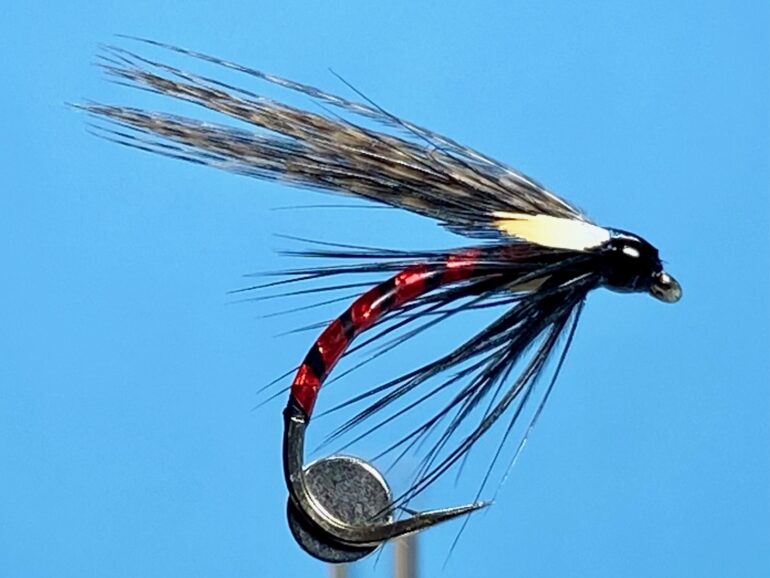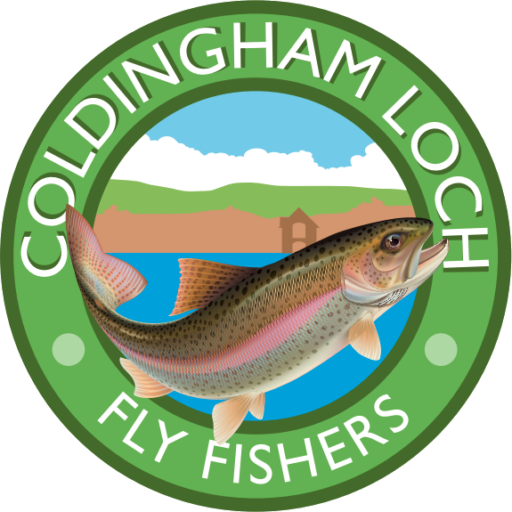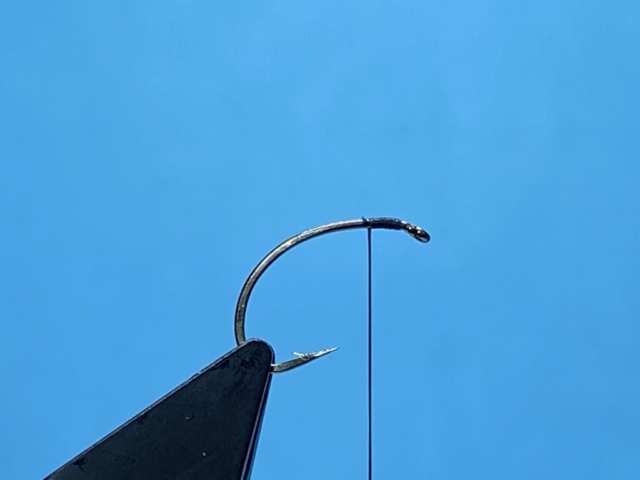
A Fly To Tie & Try April – The Irish Cormorant by Les Lockey
Fly of the Month- April by Les Lockey
The Irish Cormorant
Hook: Kamasan B100 or B110, Grub hook, sizes 10 to 14.
Thread: Black Veevus GSP, 50D, or any fine flat thread.
Rib: Red holographic tinsel.
Body: Black Veevus GSP, 50D.
Hackle: Black Chinese cock or genetic hen.
Wing: Bronze mallard.
Eyes: Split Jungle Cock nail feather.
TYING
Photo 1. With the hook secured in the vice, start the thread behind the eye and wind on a short bed of thread and remove the waste thread.
Photo 2. Tie in a length of holographic tinsel and with touching turns of thread, bind it down to well round the hook bend and return the thread to about 2mm. from the eye, again using touching turns of thread.
Photo 3. Wind the tinsel in open spirals up the body as a rib and tie it down securely at the head. Remove the excess tinsel. Make a 3 turn whip finish and remove the thread. Coat the ribbed section of the body with a thin layer of UV resin and cure with a torch.
Photo 4. Reattach the thread at the eye and remove the waste thread. Remove the fluffy fibres from the base of the hackle and trim the stem to about 2mm. in length. Wax the thread and use it to secure the hackle by the short stem.
Photo 5. Wind on no more than 2 turns of hackle, stroking back the fibres after each turn, then secure the feather with thread, and remove the excess hackle.
Photo 6. For the wing, take a strip of bronze mallard fibres about 8mm. wide, and align the tips, then holding the fibres tightly, tear the strip away from the feather stem. Gauge the feather strip for length and with the good side of the feather facing up, fold the feather slip in half and tie it down securely on top of the shank with well waxed thread.
Photo 7. With the wing in place, hold the wing and carefully cut off the waste bronze mallard fibres. Bind down the cut ends and tidy the head area as you go.
Photo 8. Take a split jungle cock nail feather and with well waxed thread, tie it in centrally so that one split nail sits on each side of the wing. Bind down the jungle cock stem to the eye, fold the feather stem back and continue to bind the feather down working back towards the wing. Remove the waste jungle cock feather.
Photo 9. Tidy the head, whip finish and varnish the head to complete the fly.
Tying tips
- This pattern is a cross between a buzzer and a cormorant and is tied in similar fashion to a lightly dressed Irish duck fly.
- A flat thread enables the hook shank to be quickly and smoothly covered, but the thread should be removed before coating the body with UV resin. If necessary, a finer thread can then be reattached in order to secure the remaining materials.
- Although the rib on this fly is red holographic tinsel, pearl or holographic silver tinsel are good alternatives.
- The usual hackle used for this pattern is a soft Chinese cock hackle, but for a bit more movement, I like to use just 1 turn of a genetic hen hackle.
- To form the wing, take the duly aligned bronze mallard strip and fold it in half so the good side of the feather faces outwards, then gauge the strip for length ensuring the tips are just longer than the bend of the hook. Now hold the wing on top of the shank and secure with a couple of tight pinch and loop turns of well waxed thread. This should be enough to hold the wing in place and allow the position and length to be assessed. Assuming the wing is sitting correctly, make a few more thread turns heading towards the hook eye for additional security. Don’t be tempted to take the thread back beyond the first thread turn used to secure the wing as this could cause the wing to become misaligned. When dealing with feather wings, it is advisable to hold the wing while using scissors to remove the waste butt end fibres as this will prevent the wing from twisting or moving while the cut is made.
Fishing hints
- This is a very good early season pattern, but other colour combinations such as olive body, pearl rib and Greenwell’s hackle or hot orange body with plain Mylar rib and furnace hackle, both with the bronze mallard wing, are well worth having in your fly box.
- Use the heavier B110 grub hook for fishing deeper in the water column at the very start of the season and change to the lighter B100 version as the water warms up.
- My preference is to fish the lighter wire B100 version on the top dropper, either as part of a team of wet flies, or in conjunction with a heavy buzzer on the point. The pattern also works well when fished as part of a team of cormorants on the washing line, usually using a long midge tip line.
- When olive midges are present, try suspending an olive version between 2 dries on a modified washing line, using a floating line.












Recent Comments